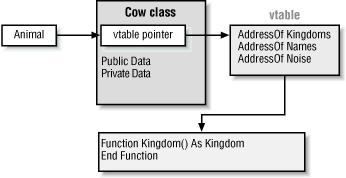Classes
One of the details VB hides from the programmer is the fact that an interface and a class are two distinct entities. This is easier to visualize once you know what a class really looks like; Figure 2.1 attempts to depict the Cow class graphically. A class is nothing more than a pointer to an array of function pointers (member functions), followed by public and private data. This array of function pointers is called a virtual function table, or vtable. This arrangement allows multiple instances of a COM component to share the same vtable, which is very efficient in terms of memory. Of course, member variables are not shared. Every instance of a component has its own copy of any public or private member variables. Also, if a class such as Cow had any methods of its own or implemented any additional interfaces, these would be added to the vtable. The order of a vtable is very important, because for all practical purposes the vtable is the physical representation of the interfaces an object has implemented.

Figure 2-1. The Cow class
Interface Identifiers
The Animal and
Cow interfaces are unique. Behind the scenes, VB
has assigned a globally unique identifier (GUID)
to both of these interfaces. A GUID that names an interface is called
an IID. The IID for Animal is {101E95AB-018E-11D3-BB7C-444553540000}. Well, actually this is a string representation of an IID. An IID is a unique ...
Get VB Shell Programming now with the O’Reilly learning platform.
O’Reilly members experience books, live events, courses curated by job role, and more from O’Reilly and nearly 200 top publishers.

